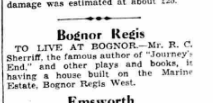Writers in Sussex: R. C. Sherriff and The Fortnight in September
- Ellen Cheshire
- Sep 1
- 2 min read
This post continues our series on writers in Sussex - those who found inspiration in its landscapes, towns and coastlines, weaving the spirit of the county into their work.
R. C. Sherriff (1896–1975) is best known for his play Journey’s End (1928), a powerful account of life in the trenches during the First World War. Sherriff’s connection to Selsey, West Sussex, was pivotal to the creation of the play. In the 1920s, he maintained a holiday home there, and the town became a second home to him. It was while staying in Selsey in 1927 that he wrote Journey’s End, drawing on his wartime experiences to craft the intimate and moving portrayal of officers on the Western Front.
The historic Selsey Pavilion hosted several early productions of Journey’s End during the 1930s. In 1933, Sherriff attended a rehearsal at the Pavilion to advise the cast before departing for Hollywood, where he went on to write screenplays including The Invisible Man (1927) and The Bride of Frankenstein (1935). Decades later, in 2018, the Pavilion marked the centenary of the Armistice with a production of Journey’s End by the Selsey Players, directed by Gillian Plowman, reaffirming the town’s enduring link to the play.

Sherriff’s connection to Bognor Regis is equally significant. It was during a holiday in the town that he conceived the idea for his 1931 novel The Fortnight in September. Observing ordinary families and holidaymakers, he imagined a fictional family’s annual seaside holiday, capturing the small rituals, fleeting joys and subtle tensions of English life by the sea.


After returning from Hollywood in 1936, Sherriff commisisoned a Spanish hacienda-style house at Aldwick, just west of Bognor town centre, overlooking Marine Park Gardens. For decades it was a striking local landmark, commemorated with an Arun District Council Blue Plaque marking Sherriff’s residence. Sadly, the house itself is also in the process of demolition.

In both Journey’s End and The Fortnight in September, Sherriff demonstrates the ways Sussex nurtured his imagination: Selsey provided the quiet, reflective environment for writing one of the 20th century’s greatest war plays, while Bognor Regis offered the observations and rhythms of everyday life that sparked a beloved novel. Nearly a century on, Sussex remains inseparable from his literary legacy.
Extracts from The Fortnight in September (1931) by R. C. Sherriff:
The Arrival at Bognor:
"The train drew up at Bognor, and the platform was bright with the early September sunshine. Children ran ahead to the beach, their laughter mingling with the cries of gulls. Mr. and Mrs. Stevens, carefully watching their belongings, felt the familiar thrill of being away from home, of stepping into a world governed by its own unhurried rhythms."
The Seaview Guesthouse:
"The Seaview boarding house stood at the far end of the promenade, neat and white, with flower boxes at every window, promising two weeks of small routines, long walks, and quiet evenings, where nothing of consequence might happen, yet everything would matter in memory."



Comments